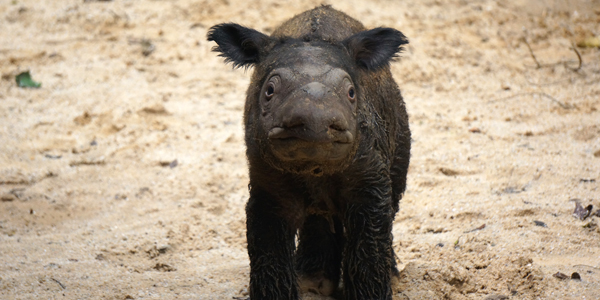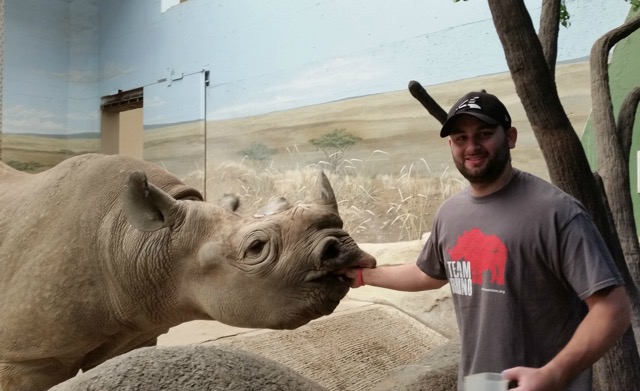Big Milestones for Sumatran Rhinos

The Sumatran rhino is the world’s most endangered rhino, with fewer than 100 individuals remaining only in Indonesia’s dense rainforests. Poaching for horn for traditional Asian medicine caused the initial decline of the species. Today, the populations are primarily threatened by small population effects such as inbreeding, human encroachment, the potential for catastrophic events, and increasingly, invasive plant species.
Over the past 2 years, the International Rhino Foundation and partners have developed a 10-year strategy for the recovery of the Sumatran rhino. In addition to intense protection, one focus is getting more babies on the ground, both in wild populations and in the captive population at the Sumatran Rhino Sanctuary in Sumatra’s Way Kambas National Park.
Two calves have been born at the tiny Sumatran Rhino Sanctuary (SRS) in the past 4 years. These represent the fourth and fifth births in a managed breeding facility, and the only one ever in an Indonesian facility. While one calf does not save a species, it’s one more Sumatran rhino on Earth – and we celebrate each and every precious birth.

With its seven rhinos, the SRS is now filled to capacity. To maximize its contribution to the long-term survival of the species, and to maintain the population’s genetic variability, the SRS needs to be able to house at least twice as many rhinos. Thanks to a very generous anonymous donor, a $2.4 million expansion is now in the works, with plans for completion in late 2017.
In addition to learning as much as possible from the captive population to benefit the conservation of the wild population, the IRF remains committed to ongoing protection of Sumatran rhinos in the wild. Together, these two strategies form a critical part of the plan to recover this precious species.
We are hopeful the Sumatran rhino population will someday thrive once again. It will take an unprecedented effort, with support and commitment.
Not everyone can make a million dollar gift, but all donors can make a big difference. One of the easiest ways to maximize your impact is to set up a recurring donation – make regular donations two, four, six, or even twelve times a year. Recurring donations are easy to set up and run automatically. Each year, this becomes a more and more popular option for our regular donors. You can even set up a recurring adoption!
Below, we’ve spotlighted a few of our recurring donors and asked why they support the IRF.
“I chose the IRF after extensive research into various charities and their effectiveness and efficient use of finances. Rhinos are one of earth’s majestic and unique creatures and I loathe how humans have treated the species. We need to fix what we broke.”
Brett Sullivan, Recurring Donor
“I give to IRF because they are one of the most effective organizations at saving rhinos. They are dedicated to their mission.”
Sara Yang, Recurring Donor
I’ve always found rhinos to be a majestic species and beautiful to watch. The preservation of species has always been my greatest passion. Support is vital at this point in our history. The world’s species are declining at an unprecedented rate. The consequences of inaction on our part will be devastating to current species on this planet but to our generation’s legacy as well.”
C. Oliver Goldsmith, Recurring Donor
“Rhinos are remarkable and charismatic, and deserve the opportunity to live free lives. I joined #TeamRhino to fight for their survival; not only for their future, but for ours too. The world is a better place with rhinos.”
Nicholas DePilla, Recurring Donor






One thought on “Big Milestones for Sumatran Rhinos”
Congratulations guys! I can not wait to see the population regrow like the white rhino! I have a few questions that I hope you can answer. I noticed your “adoption page” for the Sumatran Rhino, and I was wondering if that is all the rhinos you have. I would love to go on the page and see the progress that you guys are making with this species, and I would love to see all of the rhinos and how they are doing. I would also like to know how often you update the bio pages for the adoption rhinos. I check this website whenever I can, but I want to coordinate, so that I can organize it with my schedule. Last, but definitely not least, I want to join this organization once I get my doctorate, so I need to know what the requirements are in advance. Thank you, and I hope you can reply as soon as possible.